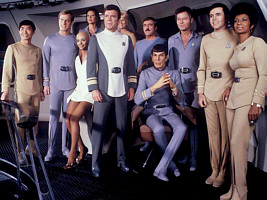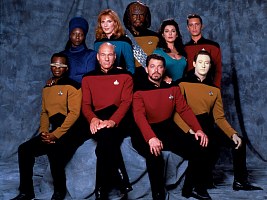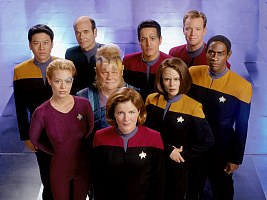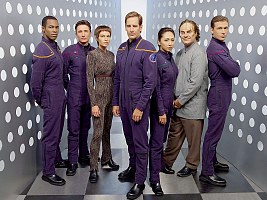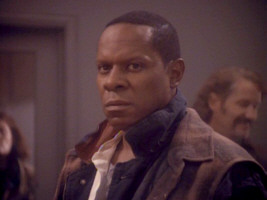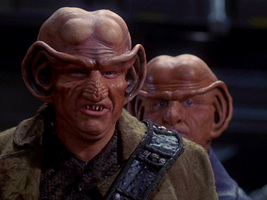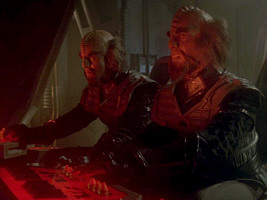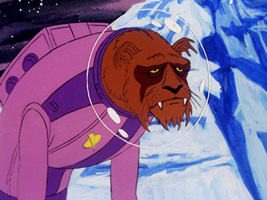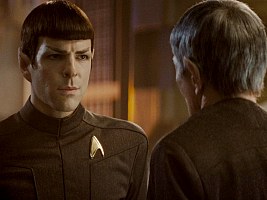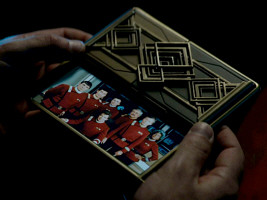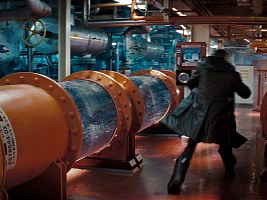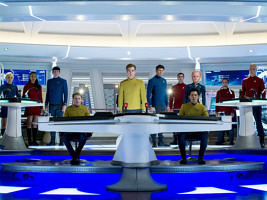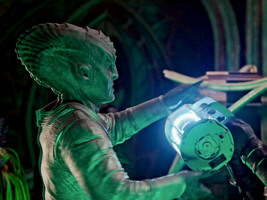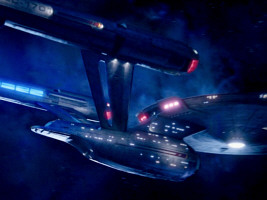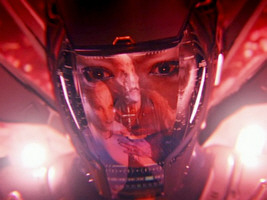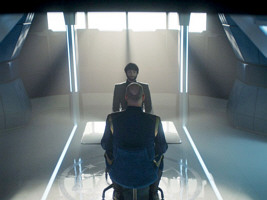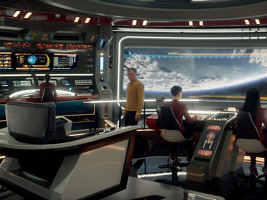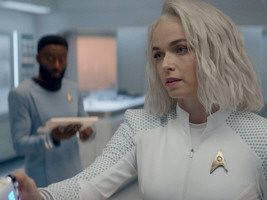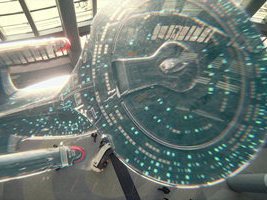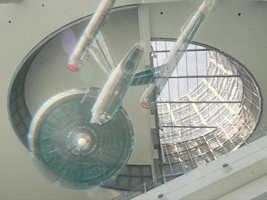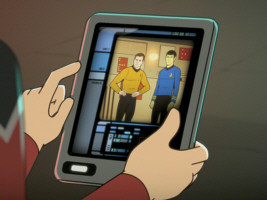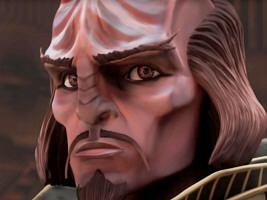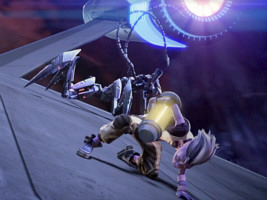The Continuities of Star Trek
Classic Star Trek ContinuityKelvin TimelineDiscovery ContinuityContinuity Workaround at EASIs Star Trek a Multiverse?
The live-action TV series and movies produced by Star Trek's copyright owners are canon by definition. Until 2009, all canon Star Trek was set in the same timeline (although owing to time travel it was frequently subject to subtle changes). In contrast, the Abrams movies explicitly take place in a detached timeline and hence in a new continuity. Although Star Trek Discovery is meant to exist in the same continuity as TOS, this official claim is hard to uphold, not only because it is a quite deliberate "visual reboot" but also because of numerous historical and technological facts that clash with classic Trek.
This article looks at the continuity of Star Trek and how the concept changed over time, from a single timeline to something like a multiverse. The article takes into account the official policy of CBS but also outlines a way to handle extreme outliers such as Discovery. Note that the purpose of this article is not to discuss whether or not the Abramsverse and Discovery/SNW are in contradiction to classic Trek, which I have already done in excruciating detail in numerous other articles and episode reviews and don't want to rehash here. Regarding the existing continuity issues, this page shows only summaries. Please follow the links to read a lot more about them.
Classic Star Trek Continuity
Official policy
"Classic" Star Trek comprises the following canon series and movies (in production order): TOS (since 1964), the TOS movies, TNG, DS9, Voyager and Enterprise (until 2005).
All these series and movies take place in the very same uninterrupted continuity. There is only one timeline. In the correct in-universe chronological order, we have Enterprise (set in the 22nd century), TOS and TOS movies (23rd century) and TNG/DS9/Voyager (24th century).

Original continuity (until 2009)
Alternate continuities, such as changes to the timeline or parallel universes, have been an integral part of Star Trek's concept since the very beginning. However, all these other continuities have in common that they either don't persist or that they remain isolated from the one that the main storyline is set in. The only notable exception is the Mirror Universe from TOS: "Mirror, Mirror" that gets revisited several times. Past incursions via time travel may either lead to an undesirable transitory timeline that needs to be fixed (Nazi Germany winning WWII in TOS: "The City on the Edge of Forever"), or the changes are considered small enough to be allowed to persist (Sisko as Gabriel Bell in DS9: "Past Tense"). In consideration of the subordinate nature of alternate continuities in the storyline, it is appropriate to omit them and simplify the history of the Star Trek Universe until 2009 as a single timeline.
Problems
There is a certain deal of discontinuities between the single incarnations of classic Star Trek. Perhaps most notably, Enterprise, Star Trek's first prequel, is a series that introduces several 22nd century technologies that are just as powerful as in TOS or even TNG. It also shows us first contact with races that realistically couldn't have taken place in the 22nd century. On the visual side, there is no good reason why the lead ship Enterprise NX-01 looks a lot like a design that would exist over 200 years later. The prime example for a visual change in classic Trek, however, is already a classic. In "Star Trek: The Motion Picture" the Klingons look different than they did in TOS. While it may have been an option to disregard this particular discontinuity, it was explicitly hinted at in DS9: "Trials and Tribble-ations" and ultimately explained in ENT: "Divergence". In its fourth season, Enterprise went on something like a "continuity repair tour" that answered this and several more questions of how the series fits into the established history.
More generally speaking, classic Star Trek had the advantage that it could pass off real-life progress regarding its props and sets as an in-universe development as long as new series were sequels. But overall, every series, including the prequel Star Trek Enterprise, usually respected what had been established before. If inconsistencies came to pass, they were sometimes generously overlooked but not openly denied or glossed over - although at least ENT: "Acquisition" (Borg not mentioned by name) and "Regeneration" (Ferengi not mentioned by name) may be blamed for the latter.
Status of Star Trek: The Animated Series
The Animated Series (TAS) is a special case, not because of continuity issues but rather due to its disputed canon status. Quality and compatibility concerns regarding this series are the principal reason why the producers as well as many fans are reluctant to accept it as fully canon. Continuity-wise, on the other hand, there are relatively few obstacles to a possible integration of TAS. Most notably, the Kzinti War (TAS: "The Slaver Weapon") can't possibly exist in the known continuity.

 At EAS, facts from The Animated Series are tagged accordingly. Pending an definite (official) decision whether this old series is canon or not, which likely won't happen, TAS has a lower weight at EAS than the various live-action series.
At EAS, facts from The Animated Series are tagged accordingly. Pending an definite (official) decision whether this old series is canon or not, which likely won't happen, TAS has a lower weight at EAS than the various live-action series.
Kelvin Timeline
Official policy
 Regarding the films set in the Abramsverse (officially: the Kelvin Timeline), there is no doubt that they are canon, just like every live-action Star Trek. But they take place in a new persistent timeline, which constitutes a different continuity. In "Star Trek (2009)", Nero's time travel and the destruction of the USS Kelvin entails a chain of events with different technical histories (a completely different Enterprise is built on the ground and launched as late as 2258) as well as different personal histories (Kirk rises from cadet straight to captain) than in classic Star Trek. The divergence culminates in the destruction of Vulcan. From a merely technical viewpoint, the Kelvin Timeline is not unlike the various alternate universes that we already know from classic Trek. The decisive difference is that the narrative departs from what was considered the main ("Prime") timeline so far.
Regarding the films set in the Abramsverse (officially: the Kelvin Timeline), there is no doubt that they are canon, just like every live-action Star Trek. But they take place in a new persistent timeline, which constitutes a different continuity. In "Star Trek (2009)", Nero's time travel and the destruction of the USS Kelvin entails a chain of events with different technical histories (a completely different Enterprise is built on the ground and launched as late as 2258) as well as different personal histories (Kirk rises from cadet straight to captain) than in classic Star Trek. The divergence culminates in the destruction of Vulcan. From a merely technical viewpoint, the Kelvin Timeline is not unlike the various alternate universes that we already know from classic Trek. The decisive difference is that the narrative departs from what was considered the main ("Prime") timeline so far.

Official Prime vs. Kelvin continuity (as of 2017)
The story of "Star Trek (2009)", the appearance of Leonard Nimoy as Spock in the first two movies and the photo of the TOS crew in "Star Trek Beyond" firmly establish the Kelvin Timeline as one that branches off from the familiar ("Prime") timeline.
Roberto Orci, co-writer of "Star Trek (2009)", explained that he envisions the new timeline as a quantum universe much like the ones in TNG: "Parallels". In his view, it exists in parallel and does not replace the Star Trek that we know. This, of course, serves to pacify fans who are concerned that the old Star Trek is erased once and for all. Orci's theory, however, clashes with the depiction of time travel in classic Star Trek that always created a new timeline that replaced the old one and that compelled the characters to go back again and restore history.
Problems
The Abramsverse movies include many more changes to the look and to technical principles of Starfleet than 25 years of divergent history since the arrival of Nero could explain. The technology of these movies is significantly more advanced than it should be (well, except for the engineering with riveted water pipes), starships including the Enterprise are a lot bigger than firmly established and the overall visual style has almost nothing in common with the one of TOS.
Fan theories
The technological and visual discrepancies are the reason why there are still different ways of how the fandom rates the continuity status of the films, in spite of Orci's clear-cut statement that a new parallel universe branches off when Nero destroys the Kelvin. Without further going into the very complex details, many see it as a total reboot that has no ties with the classic Star Trek, much like it happened with Battlestar Galactica. Others presume that the timeline was different even before Nero traveled back in time, which may explain the already existing technological divergence and huge ships but flat-out dismisses the very story of the film.
The issue of what actually happens to the continuity is further complicated by a statement from 2016 by Simon Pegg, who co-wrote "Star Trek Beyond". He suggested that the Kelvin Timeline may just as well extend into the past (a bit like in the fan suggestion about an earlier point of divergence but here apparently still caused by the Kelvin incident that for some reason affects the past as well). Yet, any canon evidence for such an unprecedented phenomenon is missing. It would have to be a part of the story to become worth considering. So Pegg's idea remains just a hypothetical possibility to grant future authors still more freedom to set new stories in any universe and any time they deem advantageous.

 At EAS, events belonging to the Kelvin Timeline are tagged accordingly. The tag indicates the different continuity, with all the due caveats regarding a possible impact on the "Prime Timeline" (which has precedence in cases of doubt).
At EAS, events belonging to the Kelvin Timeline are tagged accordingly. The tag indicates the different continuity, with all the due caveats regarding a possible impact on the "Prime Timeline" (which has precedence in cases of doubt).
Discovery Continuity
Official policy
 Star Trek Discovery is a whole new ballgame with regard to continuity. The series was conceived as a direct prequel to TOS, roughly ten years before Kirk would be in the captain's chair. The official position is that, very much unlike the Abrams films, the series is set in the exact same continuity as TOS and the other classic Star Trek series.
Star Trek Discovery is a whole new ballgame with regard to continuity. The series was conceived as a direct prequel to TOS, roughly ten years before Kirk would be in the captain's chair. The official position is that, very much unlike the Abrams films, the series is set in the exact same continuity as TOS and the other classic Star Trek series.

Official continuity (as of 2022)
Problems
The first massive problem about Discovery is its totally new look, with changes relative to classic Trek (and also relative to the Abramsverse) that go very far beyond a reasonable "visual update". The Klingon make-up, their styling and their first-season starships are just the most blatant examples. They were not updated but redesigned from scratch. Everything Starfleet just as well doesn't look like it should ten years before TOS but rather like "generic post-TNG future technology". We may decide to accept the underlying idea of a "visual reboot". We may try to accept that Discovery disregards an inherent principle of visual media, that looks have story relevance, unlike it is customary in novels. But as soon as we pretend that Discovery is perfectly in line with the rest and "only" has a new look, we effectively degrade all visuals ever created for Star Trek to illustrations like the ones in a book that merely show an artist's interpretation of the story and that may be thrown overboard for a later edition.
Many more issues arise because of Discovery-specific people, historical events and technologies that don't exist in TOS or that shouldn't exist at all in the Star Trek Universe. In an attempt to regain some continuity with classic Trek, DIS: "Such Sweet Sorrow II" explains that the existence of Michael Burnham, the USS Discovery, the spore drive, the Sphere, the AI "Control", the time travel suit and possibly several more anti-canon aspects of the series will remain "classified", that no one is allowed to ever talk about them (which I refer to as "Lex Spock"). In a similar fashion, the excursion to the Mirror Universe and Emperor Georgiou's true identity were already declared top secret at the end of the preceding season. It is neither realistic nor a desirable vision of the future that Starfleet would suppress the truth so rigidly. And that the Klingons would do the same. And that Spock would never talk about Michael Burnham, the sister he loved so much, even to his closest friend! And while the perfect secrecy is unbelievable anyway, it still leaves plenty of discrepancies that probably wouldn't fall under this ban, such as the holodeck, Klingon cloaking, the truth about Tribbles or the course of the war with the Klingons, to name only a few items from a very long list.
Discovery's fundamental redefinitions of Trek lore have repercussions on the existing Star Trek. It is inconceivable that all Klingons of TNG, DS9 or Voyager, including Worf, suddenly have to look like the DIS Klingons - although for some time this was a valid or even the officially endorsed new interpretation of the old series. Or that the original USS Enterprise NCC-1701 has two different designs and two vastly different sizes. But that is the kind of doublethink the producers apparently expect from the fans.
Even if we leave out visuals and think of Star Trek as an illustrated novel series whose look doesn't matter, its continuity is severely impaired by Discovery. Future viewers will have to watch TOS, TNG and the other classic series with the knowledge that important historical facts and technologies are kept under wraps. On many occasions in TOS, Spock would appear as a dishonest person because he never reveals his DIS-specific knowledge about artificial intelligence, ultrafast space travel, parallel dimensions or time travel, not even in extreme emergencies. As another example, Voyager needed seven years and 168 episodes to finally find a way back into the Alpha Quadrant. This involved several "drives-of-the-week", which has become a commonly ridiculed trope of the show. But according to Discovery, a still much more advanced (and arguably much more ridiculous) drive based on a fungal network and allowing instantaneous space travel, existed as long as 120 years earlier! It makes Janeway's efforts look stupid and pointless as we watch her show again.
For the third season, the setting of Discovery was radically changed. Ship and crew arrive in the far future of the 32nd century, a time in which the producers and writers are free to come up with a new history and new technologies, without causing further continuity errors. We might even want to label this (possible) future as a whole new continuity, one which is much better to reconcile with classic Trek than Discovery's 23rd century.
Fan theories
A popular fan theory used to be that Discovery is the same continuity as the Kelvin Timeline, as ostensibly evidenced by the same design style (bridge windows) and the same type of effects (phaser bolts). But this idea was ultimately refuted in Discovery's season 2 that created clear ties to TOS by establishing that Pike and Spock were on the "old" Enterprise as of 2258, as opposed to "Star Trek (2009)" where Pike is an admiral, Spock is an academy instructor and a new Enterprise is ready for launch in the same year.
In roughly the same vein, there was a rumor (allegedly coming from a "CBS insider") that Star Trek Discovery was produced under an "alternate license", the same license that also applies to the Abrams movies by Paramount and Bad Robot. This would technically make Discovery a part of the Abramsverse continuity, but as outlined in the preceding paragraph, not of the Kelvin Timeline. The rumor further gained momentum by the statement of a production designer, who said he was told to make all designs for the series "25% different" for legal reasons. Any further proof, however, is missing. There is no second source that would confirm the claims of the "CBS insider" or that would link it to the purported "25% rule". It is well possible that CBS officials or lawyers told the production people things that were not meant for the public. The "25% rule" may indeed have existed as some sort of internal guideline, not for legal reasons but to ensure that it fits with the producers' intentions to create their own new Star Trek.
Status of Star Trek: Strange New Worlds
Star Trek: Strange New Worlds (SNW) differs from Discovery because of its more optimistic tone and its episodic format. It also comes with several amendments to the designs and visual styles. Most notably, the redesign of the Klingons was reverted; the episodes since SNW: "The Broken Circle" in season 2 show the classic (TMP) make-up only.
Overall, SNW is still based on Discovery as the design ethos and the continuity is concerned. The Enterprise is essentially the same reimagined and enlarged vessel that was introduced in DIS: "Will You Take My Hand?". Also, the technology includes anachronisms (from the viewpoint of classic Trek) such as much more powerful transporters and replicators and much faster ships. Finally, there are direct continuity ties in the form of the characters Spock, Pike and Number One and their memories of the events of Discovery's second season. Besides this trio, SNW includes numerous "legacy" characters and redefines many of them. This is quite evident in the case of Christine Chapel, who is not only visually a radically different personality than in TOS.
There is a pattern in the development of the most recent (post-Discovery) Trek shows that everything set at the time of TOS is subject to be reimagined, which applies to SNW just as well as already to the animated Short Treks episode "Ephraim and Dot". The TOS movie era and beyond, on the other hand, remains largely unaffected by changes to its history, its technology level and its designs. PIC, LOW and PRO as described below are all designed not to clash with the classic continuity. As already mentioned, there is also a trend to amend some of the changes made in Discovery, which continues in SNW and in DIS itself.
Although SNW attempts to reconcile the "Disocverse" with classic Trek in some regards (such as with classic Klingons), the status is the same as that of DIS.
Continuity Workaround at EAS
Dealing with the Discoverse
The official policy is that Discovery and Strange New Worlds (the "Discoverse") are fully canon within the Prime Timeline, the only acknowledged caveat being that they take some (allegedly small) liberties on the visual side. The reality is that neither the visuals nor the other facts established in Discovery nor the character developments fit into the Prime Timeline continuity. They even retroactively damage the existing series, which would have to change or even lose their meaning in consideration of the Discoverse.
Although it offends Discoverse fans, it is imperative to apply some kind of "polluter liability". TOS or the TNG era must not suffer from harmful effects, which could make the characters, Starfleet or the technology of the later 23rd or of the 24th century look cheap or dumb. Here at EAS, I respect the official position, and I appreciate the attempts to mend at least a few of the countless continuity errors since the second season of DIS. However, I keep the Discoverse separate in a way that it has no influence on TOS and TNG. DIS and SNW may be Prime Timeline, officially speaking, but it is a different continuity when it comes to the facts and the looks of the two series. In some way, this is even the consequential continuation of the Lex Spock, the in-universe secretiveness about the USS Discovery, only that I extend it to the aspects of the series that may not fall under Starfleet's ban (whose exact extent is not clear anyway), as well as to visuals. So, as a provision to preserve the significance of classic Star Trek, DIS and SNW takes place in an isolated "Discoverse" continuity.

 At EAS, Discovery and Strange New Worlds events and facts have a "Discoverse" tag, which indicates that they may not have an impact on the history, technology and characters of the classic Prime Timeline. Even though it may be interpreted ad stigmatizing the series as "less canon", it is a caveat to prevent the pre-existing Star Trek from appearing as outdated, primitive or plain stupid. Star Trek Picard, on the other hand, qualifies as authentic Star Trek and is not tagged in any fashion.
At EAS, Discovery and Strange New Worlds events and facts have a "Discoverse" tag, which indicates that they may not have an impact on the history, technology and characters of the classic Prime Timeline. Even though it may be interpreted ad stigmatizing the series as "less canon", it is a caveat to prevent the pre-existing Star Trek from appearing as outdated, primitive or plain stupid. Star Trek Picard, on the other hand, qualifies as authentic Star Trek and is not tagged in any fashion.
Practical continuity at EAS (as of 2022)
Status of Star Trek: Picard
Although the tone of the series is very different, Star Trek: Picard (PIC) returns to a look and a history that is, for the most part, deserving of the quality mark "classic" or "unrebooted". In its first season, the series has a few references to Discovery, of which the appearance of the reboot Enterprise instead of the authentic TOS ship is the most definite one. The second and third seasons include no such crossovers at all. So a possible "backdoor" for the Discoverse to enter the classic continuity remains closed so far.
Status of Star Trek: Lower Decks
Lower Decks perfectly blends in as its style and its technology are concerned. Everything looks and works exactly as fans would have demanded from a series set in the year 2380. According to the repeated affirmations of Mike McMahan, the series is canon. Yet, several events of Lower Decks could never have happened in a non-comedic show or in a live-action show. Although the reasons are somewhat different, there are obstacles to the idea that LOW can be canon, in a similar way as it has always been the case with TAS. Anyway, with respect to the continuity, LOW totally belongs to the unrebooted Prime Timeline.

 At EAS, facts from Lower Decks (LOW) are tagged as "Trek Animated", just as TAS. It is not up to me to deny the series its canon status. But the stories of LOW have to be taken with a bigger grain of salt and may not be directly comparable to the more "serious" live action Star Trek.
At EAS, facts from Lower Decks (LOW) are tagged as "Trek Animated", just as TAS. It is not up to me to deny the series its canon status. But the stories of LOW have to be taken with a bigger grain of salt and may not be directly comparable to the more "serious" live action Star Trek.Status of Star Trek: Prodigy
Much like already Lower Decks, the computer-animated series Star Trek: Prodigy is firmly anchored in the classic continuity of the 24th century and is stated to be canon. Although there are frequent instances of cutesy humor and of cartoon physics, the stories are more mature than one might expect from a children's show. Overall, it seems fair that Prodigy should have the same canon and continuity status as Lower Decks.

 At EAS, facts from Prodigy (PRO) are tagged as "Trek Animated", just as TAS and LOW. It is not up to me to deny the series its canon status. But due to its format and target audience the stories and their visualization in PRO may not be directly comparable to live action Star Trek.
At EAS, facts from Prodigy (PRO) are tagged as "Trek Animated", just as TAS and LOW. It is not up to me to deny the series its canon status. But due to its format and target audience the stories and their visualization in PRO may not be directly comparable to live action Star Trek.
Is Star Trek a Multiverse?
When I write of Discovery being a continuity separate from TOS, it means that I consider it a different interpretation of the same timeline or universe. It is my personal opinion that DIS is a corrupted and overall less reliable depiction of the "true" looks and events that are firmly established in classic Trek. Other fans have decided that DIS should be allowed to overwrite facts, and they give it precedence over everything TOS, which they deem dated and in need of improvement. At least, we still agree on the precondition of there being two different views of the same thing.
Yet, there may be a more comprehensive solution to the dilemma. As it doesn't seem to be satisfying to have an influx of new Trek that is incompatible with classic canon and fans keep struggling over the question which is the "true" Trek, one very common suggestion is to define that Discovery (usually including SNW and sometimes also Picard) takes place in an alternate timeline or universe. So should Star Trek become a multiverse similar as Marvel's Spider-Verse?
Various alternate timelines or universes are already established in Star Trek canon:
- Most time travel events create an alternate timeline, and even though we could argue that they are meant to be ephemeral (with the notable exception of the Kelvin Timeline), they do exist at some time in some fashion and may qualify as part of a multiverse.
- The Kelvin Timeline established in "Star Trek (2009)" is an alternate timeline that persists and that led to a narrative switch, with two more movies set in this continuity.
- The Mirror Universe first seen in TOS: "Mirror, Mirror" is a persistent parallel universe, continued in several canon stories across three more Star Trek series.
- The existence of a multiverse because of quantum-level events is shown in TNG: "Parallels", although the story remains limited to this single episode.
So Star Trek has traits of a multiverse already now.
Many fans think it shouldn't be a big deal to add DIS/SNW to the list of parallel universes. And perhaps PIC as well. Or ENT and everything that takes place thereafter. And what about the animated comedies? The list of candidates goes go on and on, including various time travel events that may have created new permanent timelines. There are so many claims about parts of the canon that, in the opinion of some fans, should be moved into a separate timeline to get rid of unpleasant inconsistencies, with canon evidence supporting or at least not precluding it.
My own stance on creating more parallel timelines or universes in Star Trek is as follows:
- The existence of a parallel reality has to be an unambiguous part of the canon story (like in "Star Trek (2009)" and unlike the vague insinuations in SNW: "Tomorrow and Tomorrow and Tomorrow") to be acceptable in the first place. Without story relevance, the concept is nothing but fanwank (and it can and will be turned on its head with every tiny piece of new evidence).
- Parallel timelines or universes don't help solve the most pressing problems at all, such as how Klingons look in DIS (which is only possible after millennia of divergent evolution) or why technology works differently (which may ultimately require the laws of physics to be different). If characters and their histories are still roughly the same in the alternate reality, it is impossible to justify why other discrepancies are far more fundamental. I am aware the classic Mirror Universe defies the second law of thermodynamics, but it follows a generally different set of rules anyway than Discovery, if Discovery were meant to be a parallel universe.
- It opens a can of worms because producers and writers may pull the "alternate timeline" justification for each and every minor existing inconsistency and for each and every anti-canon story opportunity, thereby devaluing canon and continuity to a point when it becomes an inconvenient option to still adhere to it.
- The multiverse concept may become official by means of a canon story or of a producer's statement, but this will almost definitely happen without a clear indication which series or which parts thereof belong into which universe. With the borders in a multiverse being blurry, fans may and will feel entitled to dump "unpleasant" series or other developments into a universe they do not have to care for, thereby only deepening the schism in fandom.
- The existence of a multiverse is an invitation to create cross-over episodes and may serve as an excuse for stories in bad taste. The Mirror Universe excursion in Discovery's first season turned out exasperating. SNW: "Those Old Scientists", on the other hand, was a fun episode. But would we really want to see a cross-over with the SNW-Enterprise encountering the TOS-Enterprise? Or even Peck-Spock meeting an AI-generated Nimoy-Spock? No thanks.
Summarizing, I am strongly opposed to Star Trek being a multiverse as a general rule. I don't expect it to happen, but I may agree with the Discoverse (and nothing else) being officially and unambiguously declared a parallel universe, although I don't see any merit in it.
See Also
What is Canon? - definitions, reasons, interpretations and the EAS canon policy
Star Trek (2009): Reboot or Multiverse? - thoughts on the continuity and the canon status of the movie
Dealing with Continuity Issues of the Abramsverse - general thoughts and the policy at EAS
The Visual Continuity of Star Trek - examples of if and how visual continuity was maintained through the generations
Discoverse Continuity Problems - where DIS and SNW are not in line with classic Star Trek
Discovery Episode Reviews - with countless remarks on the (lack of) continuity of the series
Credits
Some screen caps from TrekCore and from Cygnus-X1.net.






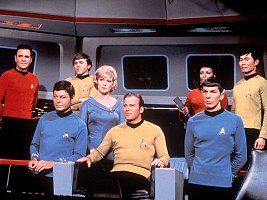
 Star Trek TOS cast
Star Trek TOS cast